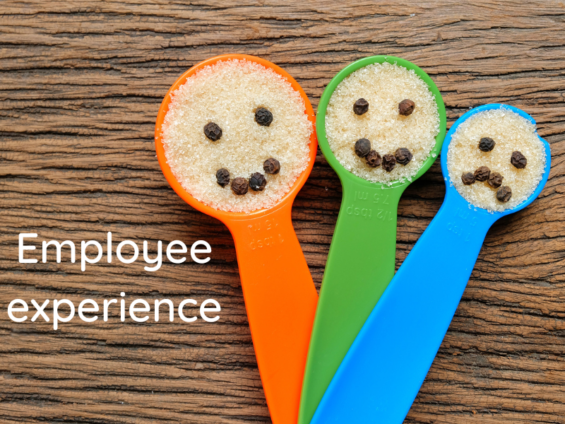11 Ways to Measure the Employee Experience

The employee experience is a hot topic these days. Today’s labour shortage means that it’s essential to retain your talent and ensure that your employees are happy. To do so, we suggest you define an employee experience strategy.
However, once implemented, how do you know if your employee experience strategy is actually working? How do you measure the benefits associated with implementing this type of strategy, when often, they may seem intangible?
As explained in our blog post: The employee experience according to Maïeutyk, employee experience is the systematic encounter between your company and all the stakeholders who work or think about working there. This includes new applicants, collaborators and, of course, your current employees.
Here are 11 ways to measure the employee experience:
1- Employee Satisfaction Surveys
The employee satisfaction survey is a survey that is conducted annually or every two years. It is generally a longer survey that includes several questions on:
- The general satisfaction of your employees;
- Their work environment;
- The access to training;
- Their use of work tools such as the intranet or others.
In addition to these general satisfaction questions, an employee satisfaction survey is used to measure whether they feel valued and recognized for their contributions to the company’s success, internal communication, and their relationship with their senior management and colleagues. As you can see, the questions are varied and should be aligned with your organization’s objectives. It is also important to include some socio-demographic questions in order to fully understand your employees’ satisfaction by department, age, role, etc.
2- Employee Engagement Surveys
Second, the employee engagement survey is a shorter survey that is conducted more frequently on specific initiatives. As the name implies, it is used to measure the level of employee engagement. Here are examples of subjects for an employee engagement survey:
- The degree to which employees are proud to work for the organization;
- Their commitment to the organization’s mission;
- Their perception of contributing to that mission, etc.
- The use of your intranet
3- Employee Retention Rate
Engaged and happy employees usually want to stay with the company. A high turnover rate is a sign of a bad employee experience. In addition, the cost of replacing people who leave and training recruits is usually high. To calculate your employee retention rate for a given period, simply follow this formula:
(# of employees at the end of the period / # of employees at the beginning of the period) * 100.
Generally speaking, the retention rate of your employees is calculated on an annual basis. However, in certain more seasonal occupations, it is important to align the frequency with the reality of your business. For example, if a higher turnover rate is noticed, it may be wise to take this measurement several times during the year. This method ensures that the root cause(s) of a lower retention rate is identified.
4- Employee Net Promoter Score (eNPS)
The eNPS is actually the number of employees who are able to recommend your company as an employer. It is one of the most commonly used metrics for employee experience measurement. eNPS is simple to measure and relatively accurate. To measure eNPS, simply ask your employees, “On a scale of 1 to 10, how likely are you to recommend our company as a place to work to someone you know?”
5- Employee Referral Rate
The eNPS is the number of employees who intend to refer their company as an employer while the employee referral rate is the number of employees who take action and refer their company. A simple tracking of referrals when hiring new candidates is enough to measure this metric. Some companies even offer a reward program for any referral that materializes over time.
6- Focus Groups to Measure the Employee Experience
On one hand, employee surveys are a great way to get quantitative data about the employee experience. On the other hand, focus groups can help your teams enrich the data obtained in the surveys by obtaining more in-depth information about how employees feel about specific initiatives in the organization. In addition, focus groups give employees the chance to develop solutions for improving your organization’s processes and to develop concrete actions on how to improve their experience. In order to ensure a more free and fair expression, we recommend that you have a third party facilitate a focus group (e.g., Maïeutyk) so as not to bias, unintentionally, of course, the participants’ answers.
7- Survey of New Candidates
This type of anonymous survey is divided into 2 categories: the survey of candidates who have participated in a job interview at your company and the survey of new hires.
Candidates who participated in a job interview
The candidate feedback survey generally assesses the overall experience of the interview process, the clarity of the job description (and its consistency throughout the recruitment stages), the effectiveness of the phone and email communication, and any suggestions for improvement.
New Hire
The onboarding process is a crucial step in the life cycle of an employee. It directly affects a new hire’s perception of the company and their willingness to continue their career with your company, even after their probationary period has ended. Onboarding interviews assess the quality of the onboarding process and the new employee’s overall perception of the company.
8- Exit Interviews
The opposite of the new applicant survey is the practice of exit interviews. An exit interview is an opportunity for a departing employee to explain the reasons for their departure and to provide feedback on their work experience. When conducted properly, an exit interview is an excellent way for organizations to gather honest and open impressions from the employee. Feedback will help improve the experience of current and future employees.
9- Promotion Rates or Lateral Moves
Generally speaking, employees appreciate the fact that there are opportunities for growth and development within their company, but it’s much better to help them see it. So, data on the percentage of your employees who have had the opportunity to grow within the company can give you very direct information about your employees’ experience in the workplace. Therefore, tracking the number of internal promotions by month, quarter or year can be a valuable key performance indicator.
10- Vacation Days Used
According to an article in LaPresse newspaper, 28% of Quebecers say they are too busy at work to take all their vacation days and the same percentage of Quebecers who take all their vacation days tend to work during their vacation.
However, several studies show that employee vacation time is actually beneficial to workplace productivity. This must be taken into account in the measurement of the employee experience!
Employees taking time off means they feel their workplace is well managed. It shows that their team is not suffering during their absence. It also means they don’t feel pressure or guilt about their absence. This is an excellent indicator to measure the employee experience.
11- Customer Experience
Finally, a favourable customer experience is correlated with the excellent work of your teams. Indeed, if your customers have a memorable experience with your company and want to come back, it’s because of the excellent work of your team in relation to your product or service. Find out how to measure customer experience with our blog post on 8 metrics to measure customer experience.
In conclusion, there are several key indicators to measure the employee experience. The eleven metrics listed above are the main ones among many others. To increase employee participation, share an overview of the results across the organization once the data collection is complete. Your teams will know that their opinion is highly valued and that actions will be taken based on the results.
Category
Share

